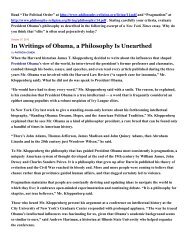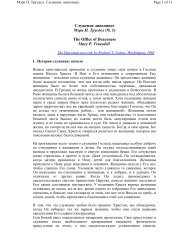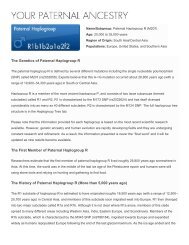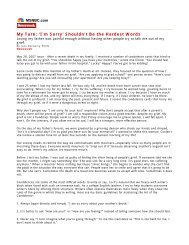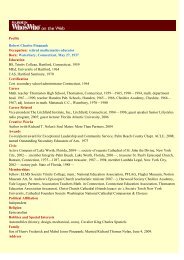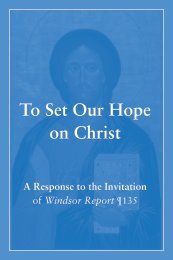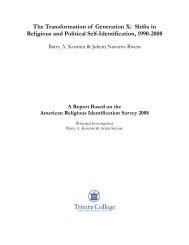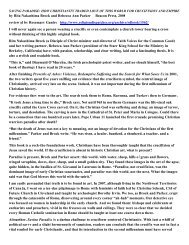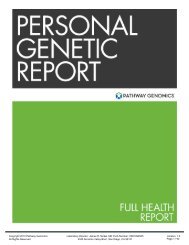Psychology and the Bible: A New Way to Read the Scriptures
Psychology and the Bible: A New Way to Read the Scriptures
Psychology and the Bible: A New Way to Read the Scriptures
You also want an ePaper? Increase the reach of your titles
YUMPU automatically turns print PDFs into web optimized ePapers that Google loves.
RBL 11/2009<br />
Ellens, J. Harold, <strong>and</strong> <strong>Way</strong>ne G. Rollins, eds.<br />
<strong>Psychology</strong> <strong>and</strong> <strong>the</strong> <strong>Bible</strong>: A <strong>New</strong> <strong>Way</strong> <strong>to</strong> <strong>Read</strong> <strong>the</strong><br />
<strong>Scriptures</strong><br />
<strong>Psychology</strong>, Religion, <strong>and</strong> Spirituality<br />
Westport, Ct.: Praeger, 2004. Pp. xvii + 325; xvii + 381;<br />
xvii + 343; xvii + 375 (4 vols.). Hardcover. $329.95.<br />
ISBN 0275983471.<br />
Ron Clark<br />
George Fox Evangelical Seminary<br />
Portl<strong>and</strong>, Oregon<br />
This four-volume series will be extensively reviewed here in four parts, each of which will<br />
discuss <strong>the</strong> twelve <strong>to</strong> fourteen chapters written by <strong>the</strong> contribu<strong>to</strong>rs. The series reflects <strong>the</strong><br />
work of <strong>the</strong> <strong>Psychology</strong> <strong>and</strong> <strong>Bible</strong> section of <strong>the</strong> Society of Biblical Literature. The series is<br />
also designed <strong>to</strong> be read by college students, clergy, <strong>and</strong> scholars seeking <strong>to</strong> explore <strong>the</strong><br />
psychological interpretation of biblical texts. The essays reflect <strong>the</strong> experiences <strong>and</strong><br />
scholarship of many diverse biblical, <strong>the</strong>ological, <strong>and</strong> psychological scholars. However, <strong>the</strong><br />
texts are well-written <strong>and</strong> intend <strong>to</strong> provide a gateway by which one might enter <strong>the</strong><br />
realm of psychological criticism of <strong>the</strong> Judeo-Christian scriptures <strong>and</strong> find a clearer<br />
underst<strong>and</strong>ing of this movement, which began in <strong>the</strong> latter part of <strong>the</strong> nineteenth<br />
century. Each volume begins with an overview of each authorial contribution by <strong>the</strong><br />
edi<strong>to</strong>rs, which helps <strong>to</strong> clarify <strong>the</strong> direction of <strong>the</strong> text.<br />
Volume 1: From Freud <strong>to</strong> Kohut<br />
This volume serves as a general introduction <strong>to</strong> <strong>the</strong> various methods <strong>and</strong> perspectives used<br />
in psychological study of <strong>the</strong> sacred texts. In <strong>the</strong> introduction Ellens <strong>and</strong> Rollins discuss<br />
<strong>the</strong> his<strong>to</strong>ry of psychological criticism <strong>and</strong> its value <strong>to</strong> biblical <strong>and</strong> religious studies. The<br />
edi<strong>to</strong>rs apply Andrew Kille’s suggestion that this approach studies <strong>the</strong> world behind <strong>the</strong><br />
This review was published by RBL ©2009 by <strong>the</strong> Society of Biblical Literature. For more information on obtaining a<br />
subscription <strong>to</strong> RBL, please visit http://www.bookreviews.org/subscribe.asp.
text, <strong>the</strong> world of <strong>the</strong> text, <strong>and</strong> <strong>the</strong> world in front of <strong>the</strong> text. Kille’s chapter fully discusses<br />
<strong>the</strong>se points of study <strong>and</strong> suggests that this helps <strong>the</strong> interpreter/pas<strong>to</strong>r <strong>to</strong> appreciate <strong>the</strong><br />
various characters <strong>and</strong> personalities in <strong>the</strong> biblical s<strong>to</strong>ries.<br />
Ilona Rashkow’s chapter on sexuality <strong>and</strong> a Freudian lens in <strong>the</strong> Hebrew <strong>Bible</strong> sheds light<br />
on <strong>the</strong> question of incest <strong>and</strong> <strong>the</strong> biblical text. Rashkow reads <strong>the</strong> Torah while reading<br />
Freud’s research concerning <strong>the</strong> Oedipus complex. This leads her <strong>to</strong> question <strong>the</strong> Torah’s<br />
silence concerning <strong>the</strong> fa<strong>the</strong>r’s relationship <strong>to</strong> <strong>the</strong>ir daughters. Rashkow admits that this is<br />
<strong>the</strong> one relationship not condemned in <strong>the</strong> Torah <strong>and</strong> suggests that Freud’s belief that<br />
fa<strong>the</strong>r-child incest was a natural part of ancient societies.<br />
<strong>Way</strong>ne Rollins’ essay on Carl Gustav Jung’s relationship with his fa<strong>the</strong>r, psychology, <strong>and</strong><br />
<strong>the</strong> <strong>Bible</strong> provides a great his<strong>to</strong>rical overview of Jung’s religious convictions <strong>and</strong> love of<br />
truth. Jung’s fa<strong>the</strong>r, a conservative Reformed clergy, seemed <strong>to</strong> ab<strong>and</strong>on his faith in light<br />
of his intellectual findings. Jung, however, seemed <strong>to</strong> grieve his fa<strong>the</strong>r’s unwillingness <strong>to</strong><br />
bridge intellectual truth with biblical faith. Rollins continues throughout this his<strong>to</strong>ry <strong>to</strong><br />
suggest that Jung’s use of <strong>the</strong> biblical texts indicated that he still believed that faith <strong>and</strong><br />
knowledge were intricately involved. Mitternacht also discusses ano<strong>the</strong>r scholar’s<br />
integration of knowledge <strong>and</strong> faith. This chapter explores Theissen’s integration of<br />
psychology <strong>and</strong> <strong>New</strong> Testament studies. Mitternacht surveys Theissen’s application of<br />
Pauline psychology <strong>to</strong> <strong>the</strong> book of Romans. For Theissen, Paul saw himself as <strong>the</strong> new<br />
Adam amidst <strong>the</strong> struggles that he faced in his ministry.<br />
Lyn Bechtel begins <strong>the</strong> next section of this volume, which explores differing aspects in <strong>the</strong><br />
field of psychology. Bechtel discusses developmental psychology <strong>and</strong> its interpretation of<br />
human development from infancy <strong>to</strong> adulthood. Using this method Bechtel, explores <strong>the</strong><br />
creation of “Adam <strong>and</strong> Eve” <strong>and</strong> <strong>the</strong>ir “fall in<strong>to</strong> sin” as a natural development from new<br />
creation (infancy) <strong>to</strong> adulthood (wise <strong>and</strong> underst<strong>and</strong>ing). Underwood’s essay suggests<br />
that <strong>the</strong> biblical text was meant <strong>to</strong> be a playful <strong>to</strong>ol <strong>to</strong> help <strong>the</strong> reader address issues that<br />
<strong>the</strong>y face that prevent <strong>the</strong>ir healing <strong>and</strong> growth. He compares this <strong>to</strong> Winnicott’s playful<br />
<strong>the</strong>rapy <strong>and</strong> “Squiggle Game.” In this game <strong>the</strong> <strong>the</strong>rapist works with <strong>the</strong> client (usually a<br />
child) <strong>to</strong> help <strong>the</strong> client <strong>to</strong> interpret a drawing by alternating drawing lines <strong>to</strong> create a<br />
project <strong>to</strong>ge<strong>the</strong>r. For Underwood, Winnicott’s playful teasing of <strong>the</strong> client helps him or<br />
her <strong>to</strong> invest in <strong>the</strong> s<strong>to</strong>ry. Underwood would suggest that <strong>the</strong> biblical texts, at times, call<br />
<strong>the</strong> “client” <strong>to</strong> enter <strong>the</strong> s<strong>to</strong>ry <strong>and</strong> take ownership by joining in this creative partnership.<br />
Petri Merenlati uses psychoanalytic criticism <strong>to</strong> observe <strong>the</strong> role of <strong>the</strong> Gospels <strong>to</strong> also<br />
entice <strong>the</strong> reader <strong>to</strong> enter <strong>the</strong> s<strong>to</strong>ry <strong>and</strong> identify with characters. These characters help <strong>the</strong><br />
reader <strong>to</strong> find meaning in <strong>the</strong> s<strong>to</strong>ry <strong>and</strong> his or her own life. William Morrow discusses<br />
PTSD in light of <strong>the</strong> trauma of Second Isaiah. For Morrow, <strong>the</strong> community of <strong>the</strong> Jews<br />
was traumatized by <strong>the</strong>ir displacement, yet <strong>the</strong> suffering servant provides an object with<br />
This review was published by RBL ©2009 by <strong>the</strong> Society of Biblical Literature. For more information on obtaining a<br />
subscription <strong>to</strong> RBL, please visit http://www.bookreviews.org/subscribe.asp.
which <strong>the</strong> community can identify <strong>and</strong> embrace in <strong>the</strong>ir own anxiety. Kamila Blessing<br />
applies Family Systems <strong>Psychology</strong> as a method of underst<strong>and</strong>ing family <strong>and</strong> interpersonal<br />
dynamics in <strong>the</strong> ancient texts. Using <strong>the</strong> birth <strong>and</strong> life of Samuel as an example,<br />
Blessing finds that God becomes <strong>the</strong> hero because God is <strong>the</strong> third part of <strong>the</strong> relationship<br />
triangle. This willingness <strong>to</strong> embrace those who were hurting <strong>and</strong> develop relationship<br />
provided hope for those whose structures began <strong>to</strong> reflect <strong>the</strong> anxiety <strong>and</strong> fear of a nation.<br />
Bernard Lang discusses Catholic <strong>the</strong>ologian Eugene Drewermann’s romantic view of <strong>the</strong><br />
biblical text. Drewermann found that religion was a major component in <strong>the</strong><br />
psychological <strong>and</strong> emotional development of <strong>the</strong> individual. Neuwoehner applied <strong>the</strong><br />
psychosymbolic approach <strong>to</strong> <strong>the</strong> interpretation of <strong>the</strong> text. The reader identifies symbols<br />
of <strong>the</strong> s<strong>to</strong>ry <strong>and</strong> amplifies <strong>the</strong>se images. These images lie deep in <strong>the</strong> subconscious of <strong>the</strong><br />
individual <strong>and</strong> help one transform through s<strong>to</strong>ry, identification, <strong>and</strong> symbols.<br />
Transformation happens not just <strong>to</strong> <strong>the</strong> individual but <strong>to</strong> <strong>the</strong> community as well.<br />
Gruenwald completes <strong>the</strong>se essays with a discussion of Kohut’s psychoanalytic approach.<br />
While God symbolizes <strong>the</strong> qualities of mercy, faith, <strong>and</strong> protection, <strong>the</strong> Messiah became a<br />
representation of this God. Gruenwald suggests that <strong>the</strong>re were many concepts of<br />
messianism, but <strong>the</strong> ancient community still sought empathy <strong>and</strong> mercy in <strong>the</strong>ir God.<br />
This attractive quality provided hope in <strong>the</strong> midst of crisis <strong>and</strong> suffering in <strong>the</strong> ancient<br />
world.<br />
Ellens completes this volume with a chapter that ties <strong>the</strong> articles <strong>to</strong> <strong>the</strong> <strong>the</strong>me of reading<br />
<strong>the</strong> scriptures through <strong>the</strong> new lens of psychology. Ellens suggests that this newer method<br />
provides an exciting opportunity <strong>to</strong> see <strong>the</strong> religious text with a fresh perspective that<br />
engages both <strong>the</strong> reader <strong>and</strong> <strong>the</strong> characters <strong>and</strong> transforms <strong>the</strong> community <strong>and</strong> individual.<br />
Volume 2: From Genesis <strong>to</strong> Apocalyptic Vision<br />
This volume focuses on psychological criticism of characters in <strong>the</strong> Torah <strong>and</strong> Prophets.<br />
These famous <strong>Bible</strong> heroes are discussed from <strong>the</strong> psychologist’s couch both his<strong>to</strong>rically<br />
<strong>and</strong> <strong>the</strong>rapeutically. Ellens <strong>and</strong> Rollins again introduce this volume by giving an overview<br />
of each chapter by examining <strong>the</strong> biblical text <strong>and</strong> <strong>the</strong> self <strong>and</strong> its relationship <strong>to</strong> God.<br />
Walter Wink discusses Jacob’s deviousness as a reflection of his inner wounds as a man.<br />
As <strong>the</strong> second born he was manipulated, neglected, <strong>and</strong> finally wrestled with himself <strong>and</strong><br />
<strong>the</strong> ego. In chapter 3 Ellens suggests that <strong>the</strong> fall (Gen 2–3) was an expression of Adam’s<br />
desire for differentiation from God. The psychodynamics of this fall/sin involve God’s<br />
willingness <strong>to</strong> confront <strong>the</strong> new creature <strong>and</strong> Adam’s will <strong>to</strong> rebel <strong>and</strong> seek independence.<br />
Rashkow discusses fa<strong>the</strong>r-daughter incest in <strong>the</strong> s<strong>to</strong>ries of Eve <strong>and</strong> Lot’s daughters. With<br />
Freud’s rejection of fa<strong>the</strong>r-daughter seduction for <strong>the</strong> Oedipus complex, Rashkow suggests<br />
This review was published by RBL ©2009 by <strong>the</strong> Society of Biblical Literature. For more information on obtaining a<br />
subscription <strong>to</strong> RBL, please visit http://www.bookreviews.org/subscribe.asp.
that Eve was seduced by <strong>the</strong> serpent <strong>and</strong> God, while Lot’s daughters were also seduced by a<br />
drunken fa<strong>the</strong>r. For Rashkow, <strong>the</strong> biblical text opens <strong>the</strong> door for incest as an acceptable<br />
practice by <strong>the</strong> fa<strong>the</strong>r in <strong>the</strong> ancient world. Later in <strong>the</strong> volume Rashkow discusses <strong>the</strong><br />
names of God <strong>and</strong> phallic power. The discussion Moses has with God concerning <strong>the</strong><br />
name <strong>and</strong> God’s vague response suggests <strong>to</strong> Rashkow that Yahweh expresses fear in<br />
revealing this power <strong>and</strong> control <strong>to</strong> Moses. Kille next discusses Jacob as one who<br />
constantly confronted his own ego through conflict with those who threatened him.<br />
Through <strong>the</strong>se conflicts Jacob experienced a sense of differentiation <strong>and</strong> became more<br />
complete<br />
Ano<strong>the</strong>r section of <strong>the</strong> volume offers discussions of <strong>the</strong> Prophets from a psychological<br />
perspective. André LaCocque discusses Jonah from <strong>the</strong> personality of one who was angry<br />
with his enemies. Jonah also resisted God’s desire <strong>to</strong> practice compassion <strong>and</strong> mercy.<br />
Jonah, according <strong>to</strong> LaCocque, is <strong>the</strong> antihero of <strong>the</strong> s<strong>to</strong>ry. Two chapters later Dan Merkur<br />
offers a psychoanalysis of Jeremiah. He suggests that Jeremiah’s preaching was his own<br />
struggle <strong>to</strong> repent <strong>and</strong> accept his fate from Yahweh. He accuses Jeremiah of hallucinations,<br />
misinformation, <strong>and</strong> immaturity when it came <strong>to</strong> living <strong>the</strong> message of God. Jeremiah’s<br />
prophecies seem <strong>to</strong> be more an examination with his own struggle <strong>to</strong> repent than a<br />
message <strong>to</strong> a rebellious nation. However, Jeremiah identified with <strong>the</strong> people of Israel <strong>and</strong><br />
used himself as an example for <strong>the</strong> Jewish nation. Schmitt, Jobling, <strong>and</strong> Garber perform<br />
various evaluations of Ezekiel as a prophet, trauma survivor, <strong>and</strong> victim of PTSD. This<br />
seems <strong>to</strong> explain his erratic behavior, graphic preaching, <strong>and</strong> possible sexual issues.<br />
Ezekiel’s wild s<strong>to</strong>ries <strong>and</strong> bizarre experiences also suggest that he wrestled with a God who<br />
showed compassion <strong>to</strong> a rebellious prophet <strong>and</strong> nation. Kille discusses Amos 5:18–20 in<br />
<strong>the</strong> next essay. His emphasis on <strong>the</strong> “Day of Yahweh” <strong>and</strong> <strong>the</strong> woe oracle also indicates<br />
that <strong>the</strong> nation of Israel, while longing for this day, was living in a state of denial that <strong>the</strong><br />
prophet sought <strong>to</strong> tease out with his expression of <strong>the</strong> Day of Yahweh as destruction <strong>and</strong><br />
fear. Martin Buss closes <strong>the</strong> essays concerning <strong>the</strong> prophets with his discussion of selfhood<br />
<strong>and</strong> <strong>the</strong> prophets. For Buss, <strong>the</strong> prophetic messages expressed <strong>the</strong> prophets’ desire for<br />
action <strong>and</strong> <strong>the</strong>ir identification with God’s emotions.<br />
Essays in this volume also address <strong>the</strong> Writings <strong>and</strong> a pseudepigraphal text. Bernhard Lang<br />
focuses on Proverbs <strong>and</strong> Lady Wisdom. This goddess seemed <strong>to</strong> be a remnant of ancient<br />
Israel’s poly<strong>the</strong>istic worldview. For Lang, Lady Wisdom was also <strong>the</strong> student/scribe’s<br />
personal/protec<strong>to</strong>r god or goddess. Wisdom was considered a construct of <strong>the</strong> scribe who<br />
continued <strong>to</strong> live on in <strong>the</strong> minds of those seeking a spiritual protec<strong>to</strong>r. Merkur discusses<br />
<strong>the</strong> book of Job as psycho<strong>the</strong>rapeutic change where <strong>the</strong> reader observes Job’s<br />
transformation. However, Merkur suggests that <strong>the</strong> end of <strong>the</strong> transformation was still as<br />
unsettling as <strong>the</strong> original suffering of Job. For Merkur, <strong>the</strong> character’s development was<br />
much more exciting than <strong>the</strong> book as literature. Daschke emphasizes 4 Ezra <strong>and</strong> <strong>the</strong><br />
This review was published by RBL ©2009 by <strong>the</strong> Society of Biblical Literature. For more information on obtaining a<br />
subscription <strong>to</strong> RBL, please visit http://www.bookreviews.org/subscribe.asp.
character’s loss, grief, <strong>and</strong> encounter with o<strong>the</strong>r grieving characters. Daschke believes that<br />
<strong>the</strong> angel assumed <strong>the</strong> role of <strong>the</strong>rapist <strong>to</strong> console <strong>and</strong> develop <strong>the</strong> writer. Finally, a second<br />
essay by Merkur concerns <strong>the</strong> visionary practices of Jewish apocalyptic. For Merkur, <strong>the</strong><br />
author experienced grief, sadness, trauma, <strong>and</strong> suffering. This experience is different from<br />
those that require prophecy through sleep deprivation, fear, mourning, trances, bipolar<br />
episodes, or erratic behavior. However, apocalyptic literature manipulates <strong>the</strong> ego <strong>to</strong><br />
address issues out of <strong>the</strong> control of <strong>the</strong> reader.<br />
While this volume does not end with a conclusion, it provides a glossary in <strong>the</strong> back for<br />
<strong>the</strong> student learning a new vocabulary.<br />
Volume 3: From Gospel <strong>to</strong> Gnostics<br />
This volume discusses <strong>the</strong> Gospel accounts of <strong>the</strong> life, death, <strong>and</strong> resurrection of Jesus as a<br />
case for psychology. Only one chapter discusses <strong>the</strong> gnostic texts. Ellens <strong>and</strong> Robins again<br />
introduce this volume by discussing <strong>the</strong> value of <strong>the</strong> Gospels in <strong>the</strong> study of psychology.<br />
Jack Miles has suggested that <strong>the</strong>ology can “activate archetypal truths anchored deep in<br />
<strong>the</strong> soul.” (1) Ellens <strong>and</strong> Robins not only survey <strong>the</strong> contents of this volume; <strong>the</strong>y<br />
integrate <strong>the</strong> chapters as support for <strong>the</strong> study of religion <strong>and</strong> psychology. For <strong>the</strong> edi<strong>to</strong>rs,<br />
<strong>the</strong> Gospel accounts help <strong>to</strong> present experiences <strong>and</strong> inform <strong>and</strong> transform readers. This<br />
happens through <strong>the</strong> common symbols of religions, narratives, biblical personalities, <strong>and</strong><br />
religious phenomena. Concepts of <strong>the</strong> soul <strong>and</strong> psyche, along with hermeneutics (<strong>the</strong><br />
world between <strong>the</strong> reader <strong>and</strong> <strong>the</strong> text), also work <strong>to</strong> transform <strong>the</strong> reader of <strong>the</strong>se<br />
accounts.<br />
Walter Wink discusses his struggle <strong>to</strong> apply his doc<strong>to</strong>ral research <strong>to</strong> <strong>the</strong> parishioners where<br />
he preaches. His discussion of Jacob’s wrestling with himself (his shadow) seems <strong>to</strong> be a<br />
metaphor for our wrestling with <strong>the</strong> text <strong>and</strong> with his<strong>to</strong>rical criticism. For Wink, his<strong>to</strong>rical<br />
criticism seems <strong>to</strong> isolate <strong>the</strong> reader from engaging <strong>the</strong> text <strong>and</strong> allow it <strong>to</strong> transform him<br />
or her. Ralph Underwood engages Mark 15 with object relations <strong>the</strong>ory. In his view, <strong>the</strong><br />
reader observes <strong>and</strong> embodies <strong>the</strong> reading as God’s suffering <strong>and</strong> my suffering. Kamila<br />
Blessing follows this with a discussion concerning Jesus’ parables <strong>and</strong> Erickson’s confusion<br />
teachers. For Blessing, <strong>the</strong> parables not only <strong>to</strong>ld a s<strong>to</strong>ry; <strong>the</strong>y confused, confronted, <strong>and</strong><br />
caused <strong>the</strong> reader <strong>to</strong> transform through <strong>the</strong> cognitive dissonance <strong>the</strong>y produced in <strong>the</strong><br />
s<strong>to</strong>ry.<br />
Kari Syreeni’s chapter on grief work <strong>and</strong> <strong>the</strong> Gospels indicates that <strong>the</strong> resurrection was a<br />
coping mechanism for <strong>the</strong> community facing denial, anger, <strong>and</strong> hopelessness in <strong>the</strong> death<br />
of <strong>the</strong>ir teacher. For Syreeni, <strong>the</strong> s<strong>to</strong>ries of <strong>the</strong> risen Jesus provided comfort <strong>to</strong> those<br />
grieving <strong>the</strong> passion. Petri Merenlahti suggests that <strong>the</strong> manly Jesus in Mark was created<br />
This review was published by RBL ©2009 by <strong>the</strong> Society of Biblical Literature. For more information on obtaining a<br />
subscription <strong>to</strong> RBL, please visit http://www.bookreviews.org/subscribe.asp.
y <strong>the</strong> community <strong>to</strong> give a sense of pleasure <strong>and</strong> joy in <strong>the</strong> retelling of this Gospel<br />
narrative. Michael <strong>New</strong>heart <strong>and</strong> Paul Anderson discuss <strong>the</strong> Gospel of John <strong>and</strong><br />
psychodynamic culture. <strong>New</strong>heart indicates that <strong>the</strong> symbols of John’s text (water, reign<br />
of God, shepherds, <strong>and</strong> bread) were designed <strong>to</strong> identify with <strong>the</strong> reader <strong>and</strong> guide him or<br />
her <strong>to</strong> transformation. Anderson’s essay focuses on <strong>the</strong> dynamic tension in <strong>the</strong> narrative<br />
designed <strong>to</strong> help o<strong>the</strong>rs develop <strong>the</strong>ir faith <strong>and</strong> grow through suffering <strong>and</strong> stress.<br />
The letters attributed <strong>to</strong> <strong>the</strong> apostle Paul are <strong>the</strong> subject of <strong>the</strong> next essays. Anthony Bash<br />
focuses on 2 Cor 10–13 from a psychodynamic approach. He suggests that Paul’s<br />
defensiveness expressed his ego’s defensiveness. The text also illustrates <strong>the</strong> classic<br />
displacement, denial, <strong>and</strong> splitting that happens when <strong>the</strong> ego feels threatened. Blessing<br />
applies triangles <strong>to</strong> Gal 1–2 as Paul’s method of calling <strong>the</strong> community <strong>to</strong> identify with<br />
Jesus <strong>and</strong> develop <strong>the</strong>ir relationship with <strong>the</strong>ir Messiah. Dieter Mitternacht approaches<br />
Galatians <strong>and</strong> <strong>the</strong> opponents of Paul with a nontraditional view. For Mitternacht, <strong>the</strong><br />
opponents were not Judaizers who forced <strong>the</strong> Galatians <strong>to</strong> be circumcised. The Galatian<br />
congregations were being challenged <strong>to</strong> identify with <strong>the</strong> humiliation of Jesus <strong>and</strong> <strong>the</strong><br />
cross <strong>and</strong> resist <strong>the</strong> social pressure from those opposing <strong>the</strong> simplicity of <strong>the</strong> gospel. Paul<br />
also challenges <strong>the</strong> community in his willingness <strong>to</strong> model this humility <strong>and</strong> call <strong>the</strong>m <strong>to</strong><br />
follow <strong>the</strong> way of Jesus.<br />
Charles Davis <strong>and</strong> Ellens explore apocalyptic texts. Davis discusses Rev 17 as psychic drama<br />
as an inner desire <strong>to</strong> find personal identity in <strong>the</strong> war between <strong>the</strong> Christ <strong>and</strong> antichrist.<br />
Ellens suggested that <strong>the</strong> apocalypse provided a response <strong>to</strong> <strong>the</strong> community’s loss,<br />
suffering, <strong>and</strong> death in Jesus. Apocalypse provided hope for a grieving community<br />
expecting <strong>the</strong> parousia of Jesus.<br />
Jill McNish expresses <strong>the</strong> psychology of shame as rooted in <strong>the</strong> life <strong>and</strong> ministry of Jesus.<br />
Jesus embraced <strong>the</strong> life of shame in <strong>the</strong> humiliation of <strong>the</strong> incarnation <strong>and</strong> provided an<br />
answer <strong>to</strong> this shame through relationship, acceptance, his righteousness, forgiveness,<br />
mercy, <strong>and</strong> compassion. David Miller encourages readers <strong>to</strong> accept <strong>the</strong> similarities<br />
between biblical imagery <strong>and</strong> likeness. For Miller, <strong>the</strong> reader has an opportunity <strong>to</strong><br />
identify with <strong>the</strong> images in <strong>the</strong> biblical world <strong>and</strong> find psychological wholeness. Rollins<br />
examines <strong>the</strong> his<strong>to</strong>rical interpretation of psyche, soul, <strong>and</strong> self as expressions of <strong>the</strong> inner<br />
human consciousness. Finally, Schuyler Brown discusses gnostic language in <strong>the</strong> texts<br />
concerning begotten <strong>and</strong> <strong>the</strong> nature of God. Brown accuses <strong>the</strong> church of removing this<br />
intellectual level of gnosis for a basic level of confessional <strong>the</strong>ology.<br />
This review was published by RBL ©2009 by <strong>the</strong> Society of Biblical Literature. For more information on obtaining a<br />
subscription <strong>to</strong> RBL, please visit http://www.bookreviews.org/subscribe.asp.
Volume 4: From Christ <strong>to</strong> Jesus<br />
This volume emphasizes <strong>the</strong> life of Christ as a model for personal transformation. Ellens<br />
<strong>and</strong> Rollins introduce <strong>the</strong> volume asking <strong>the</strong> age-old question whe<strong>the</strong>r <strong>the</strong> divine man<br />
emerged from <strong>the</strong> his<strong>to</strong>rical man or if <strong>the</strong> his<strong>to</strong>rical man gave birth <strong>to</strong> <strong>the</strong> divine man.<br />
Ellens <strong>and</strong> Rollins suggest that <strong>the</strong> search for <strong>the</strong> his<strong>to</strong>rical Jesus needs <strong>to</strong> be replaced by<br />
<strong>the</strong> study of <strong>the</strong> social <strong>and</strong> psychology of Jesus. They indicate that Jesus did not leave any<br />
written material, in order <strong>to</strong> prevent <strong>the</strong> inflated projections of <strong>the</strong> written word <strong>and</strong><br />
because he trusted <strong>the</strong> power of human imagination <strong>to</strong> help <strong>the</strong> movements go forward.<br />
Ellens’s next chapter suggests that <strong>the</strong> confessional church developed a divinity model of<br />
Jesus. Confessional <strong>the</strong>ology, ra<strong>the</strong>r than his<strong>to</strong>rical information, is responsible for <strong>the</strong><br />
divine Jesus.<br />
James Charlesworth expresses that a psychobiography of Jesus provides <strong>the</strong> reader with a<br />
convenient <strong>to</strong>ol <strong>to</strong> underst<strong>and</strong> Jesus in his setting. The social interaction of Jesus with <strong>the</strong><br />
crowds, his charismatic nature, <strong>the</strong> culture of pilgrimage, <strong>and</strong> <strong>the</strong> purification rites <strong>and</strong><br />
<strong>the</strong>ir dangers suggest that Jesus’ self-underst<strong>and</strong>ing was an important process in <strong>the</strong> life of<br />
this Galilean. John Miller focuses on <strong>the</strong> psychology of males in <strong>the</strong>ir thirties <strong>and</strong> <strong>the</strong>ir<br />
experiences of transition, vision, <strong>and</strong> relationships. For Miller, Jesus exhibits classic signs<br />
of a thirty-year-old man who men<strong>to</strong>rs, dreams, <strong>and</strong> matures in a culture where males must<br />
adapt <strong>to</strong> <strong>the</strong>ir environment.<br />
Donald Capps authors four chapters in this volume. He proposes a psychobiography of<br />
Jesus as one who felt a disconnection from his parents, especially his fa<strong>the</strong>r <strong>and</strong> stepfa<strong>the</strong>r.<br />
This was reflected by melancholy, a desire for a fa<strong>the</strong>r figure, <strong>and</strong> hope of divine reversal.<br />
Capps next explores Albert Schweitzer’s critique of psychologists as being ineffective in<br />
<strong>the</strong> study of Jesus. Capps indicates that ancient cultures experienced hallucinations <strong>and</strong><br />
emotional dreams as part of <strong>the</strong>ir natural experiences. He next illustrates Jesus as a power<br />
tactician in <strong>the</strong> way Jesus became known, built an organization, <strong>and</strong> collected a following.<br />
This model, suggested by Jay Haley, seemed practical. However, Haley proposed that Jesus<br />
miscalculated his role by offending <strong>the</strong> Pharisees <strong>and</strong> thus was murdered. Capps indicates<br />
that Jesus used a surrender tactic that discredited <strong>the</strong> Pharisees <strong>and</strong> those oppressing o<strong>the</strong>rs.<br />
Capps also writes that Jesus lifted <strong>the</strong> oppression of o<strong>the</strong>rs through s<strong>to</strong>ry, words, <strong>and</strong> vision<br />
as a numinous presence.<br />
Walter Wink focuses on Jesus’ original impulse <strong>to</strong> overturn oppression. The archetypal<br />
underst<strong>and</strong>ing of <strong>the</strong> Son of Man reflected <strong>the</strong> ancient belief that God would overcome<br />
<strong>the</strong> oppression of all people. Wink suggests that <strong>the</strong> church return <strong>to</strong> this impulse <strong>and</strong>, in<br />
turn, model <strong>the</strong> Son of Man’s role in <strong>the</strong> community. In <strong>the</strong> next essay Andries van<br />
Aarde examines Jesus as a figure who displayed qualities of one without a fa<strong>the</strong>r figure.<br />
This review was published by RBL ©2009 by <strong>the</strong> Society of Biblical Literature. For more information on obtaining a<br />
subscription <strong>to</strong> RBL, please visit http://www.bookreviews.org/subscribe.asp.
Jesus associated with <strong>the</strong> fa<strong>the</strong>rless, single women, <strong>and</strong> <strong>the</strong> oppressed because he, <strong>to</strong>o, had<br />
been neglected or ab<strong>and</strong>oned by a fa<strong>the</strong>r. Anderson, Ellens, <strong>and</strong> Fowler examine each<br />
o<strong>the</strong>r’s works in <strong>the</strong> Gospels as cognitive-critical analysis. In this chapter each author<br />
suggests that psychological study provides a better underst<strong>and</strong>ing of <strong>the</strong> text <strong>and</strong><br />
characters than <strong>the</strong> traditional his<strong>to</strong>rical-critical method that has dominated biblical studies<br />
for decades.<br />
Hal Childs explains that <strong>the</strong> traditional his<strong>to</strong>rical study of <strong>the</strong> <strong>Bible</strong> is guilty of projecting<br />
<strong>the</strong> scholar’s views in<strong>to</strong> <strong>the</strong> text. Anderson suggests that Jesus’ deeds transformed<br />
individuals through dissonance in common <strong>the</strong>mes found in <strong>the</strong> Gospels. For Anderson,<br />
<strong>the</strong> multiple attestations for Jesus’ relationship with John <strong>the</strong> Baptist, cleansing <strong>the</strong><br />
temple, healing on <strong>the</strong> Sabbath, eating with sinners, <strong>and</strong> references <strong>to</strong> God as Fa<strong>the</strong>r<br />
provide key archetypes for psychological study in <strong>the</strong> transformation of <strong>the</strong> reader.<br />
Schuyler Brown concludes this volume by suggesting that <strong>the</strong> language of <strong>the</strong> biblical text<br />
opens <strong>the</strong> door for <strong>the</strong> psyche <strong>to</strong> engage <strong>the</strong> world of <strong>the</strong> <strong>Bible</strong> <strong>and</strong> experience<br />
transformation.<br />
As someone who has met many of <strong>the</strong> authors <strong>and</strong> listened <strong>to</strong> presentations at <strong>the</strong> SBL<br />
Annual Meeting, I enjoyed reading <strong>the</strong>ir contributions <strong>to</strong> this series. I have had <strong>the</strong><br />
benefit of learning more in this area from Ellens <strong>and</strong> Robbins through <strong>the</strong>ir continued<br />
work with <strong>the</strong> various sessions held at <strong>the</strong> national conventions throughout <strong>the</strong> past five<br />
years. The field of psychology <strong>and</strong> <strong>Bible</strong> is a growing discipline <strong>and</strong> one needed in <strong>the</strong><br />
field of biblical studies. This four-volume series is valuable <strong>to</strong>ol for seminary classes that<br />
seek <strong>to</strong> introduce this discipline <strong>to</strong> <strong>the</strong> student. While <strong>the</strong> four volumes are quite lengthy,<br />
<strong>the</strong> series provides <strong>the</strong> reader with a thorough overview of <strong>the</strong> field <strong>and</strong> examples of how<br />
this work is applied <strong>to</strong> <strong>the</strong> various genres of <strong>the</strong> <strong>Bible</strong>. The texts are easily unders<strong>to</strong>od <strong>and</strong><br />
make this series valuable for clergy who are interested in developing ano<strong>the</strong>r skill in<br />
biblical interpretation.<br />
This review was published by RBL ©2009 by <strong>the</strong> Society of Biblical Literature. For more information on obtaining a<br />
subscription <strong>to</strong> RBL, please visit http://www.bookreviews.org/subscribe.asp.



